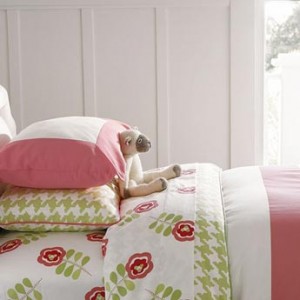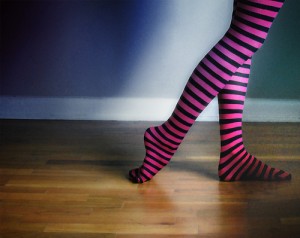Safe And Sound – How to ensure your child's room is a germ-free zone
November 4th, 2009 by adminEveryone knows that kids are notorious for putting things in their mouths. And, if your child suffers from allergies, you know just how challenging it can be to protect them from the various environmental hazards that constantly crop up from nowhere. Your child spends a lot of time in their own bedroom. It is where they sleep, dress and play. Finding hygienic and safe fabrics and furnishings for decorating children’s bedrooms is an important, but often challenging task. Just knowing where to start can be overwhelming. Panic not. With a bit of know-how you can transform your child’s bedroom into something that is not only aesthetically appealing, but also good for their health.
Flooring
If hygiene is a priority for your child’s bedroom, then flooring should be your first port of call. Most homes come furnished with carpeting. However, it is the least favourable floor covering, and is excellent at trapping and hiding allergens. Dirt, dust mites and germs can live in the pile and padding for a very long time, so the best thing to do is get rid of your carpet altogether.
Other healthier and more affordable options are available. Choose a nonporous flooring material such as tile, wood or bamboo. Bamboo is also a highly sustainable material, making it environmentally friendly and an added eco bonus for the ethically minded. Pay attention to the installation process with all types of flooring. For example, wood flooring can be installed using various methods, including toxic glues. Instead, choose a product that floats on the subfloor and snaps tightly together with no additional adhesive to irritate sensitive lungs.
Cork is another material that is ideal for children’s rooms. It is not only hypoallergenic, but also soft and easy to walk on. Surprisingly, despite the spongy nature of the material, it doesn’t harbour dirt, dust mites or allergens. It is one of the most hygienic options for decorating your children’s bedrooms.
While using hard flooring material is better for keeping things clean, they can be boring to look at. One of the best ways to freshen the space is to add a throw rug. Choose the material carefully. You want the rug to be able to take the abuse that the kids will surely give it, but also be able to be laundered easily so that little nasty things aren’t trapped inside. The best choices are natural cotton or linen. They are both durable and easy to clean. Cotton rugs can be thrown into a washing machine, whereas linen is hypoallergenic and naturally resistant to germs, hence why linen sheets are used so frequently in hospitals, and linen is one of the only natural materials used in the human body during operations.
Furnishings and Bedding

Once you have taken care of the flooring, it’s time to think about furnishings. Again, natural materials shine in this area. It is possible to buy dressers, beds and other furniture that is either unfinished or naturally finished with things like mineral oil. This type of furniture can be harder to clean than a varnished product, however, so keep plenty of Magic Erasers on hand if your child is a budding interior designer himself. You also may want to look into metal. Metal is an easier to clean choice and doesn’t hold dirt. However, be sure that all edges are rounded and that there is no possibility of the piece coming apart and exposing the child to sharp corners.
The bedding in your child’s room is probably the biggest culprit when it comes to matters of hygiene. Your child is in contact with the bedding every day. Dirt, dust mites and allergens thrive and multiply in the warm, moist environment. Choose only natural, hypoallergenic bedding materials, such as silk, bamboo, cotton or linen. Linen, bamboo and silk naturally kill most common allergens and can be mixed with other fibres, such as cotton, to make a more comfortable and durable bedding material. Cotton is ideal because it is easy to launder and is naturally free from allergens when processed properly. It is also available in dozens of styles, colours and patterns, making it the ideal choice for children’s bedding. These fabrics are also perfect for other applications in your child’s room, such as curtains and pillows.
Whichever material you choose for your child’s bedding, it is important to launder it regularly. Aim for once a week as a minimum. If your child has more severe allergies, you may even consider laundering or airing it out several times a week.
Toys and Accessories
Making sure your child’s toys are safe is extremely important. Toy manufacturers often neglect to make their products hypoallergenic and germ-resistant. Luckily, after care products are readilly available to help you manage the muck. Soft toys like teddy bears can be laundered with solutions to make them less likely to hold allergens. Hard objects can be regularly soaked or wiped down with an antibacterial wipe. While more and more companies are tapping into this niche cleaning market, wood toys are making a comeback. Also, keep an eye out for items that are made with natural materials or pre-treated to repel allergens. Certainly worth a google-search!
You may also like
On November 18th, 2022 Colin wrote on the subject of Company News and Press Releases.
Get the Look: Pantone Colour of the Year 2021
On January 22nd, 2021 Debbie wrote on the subject of Colour schemes, Industry News, Interiors and Ideas.
Forget Feature Walls, What About a Statement Ceiling?
On April 3rd, 2018 Debbie wrote on the subject of Fun Stuff, Interiors and Ideas.





 0
0
